The Rave
Hydrofoil
Redefining Fun, Speed
& Comfort
by Thom Burns
"A Boat That Flies"
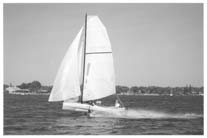 I ordered the boat before it was in production after having sailed the
prototypes a couple of times in Florida. I took possession just before Labor Day, which in
this part of the world means I had about a month to sail it before being driven off the
lake by ol’ man winter. I’ve been holding off writing this review for awhile
because I wanted to confidently say what this boat really does. That confidence came
together when I attended the first national RAVE hydrofoil clinic held at Jensen Beach,
Florida in April.
I ordered the boat before it was in production after having sailed the
prototypes a couple of times in Florida. I took possession just before Labor Day, which in
this part of the world means I had about a month to sail it before being driven off the
lake by ol’ man winter. I’ve been holding off writing this review for awhile
because I wanted to confidently say what this boat really does. That confidence came
together when I attended the first national RAVE hydrofoil clinic held at Jensen Beach,
Florida in April.
The entire design team from Hydrosail, the one-design class
president and the Wilderness Systems
factory point man were there. Ten of us from the clinic, ranging from new buyers to
dealers, really learned this boat with most of its bells and whistles.
Background
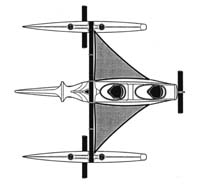 Before diving into the particular characteristics of the Rave let’s review a couple of principles of boatspeed as
I understand them.
Before diving into the particular characteristics of the Rave let’s review a couple of principles of boatspeed as
I understand them.
Most sailboats, including my racing keelboat, bore holes in the water.
They are restricted to a top speed by the bow wave they are pushing and towing through the
water. This top speed, called hull speed, is usually defined by a formula. This formula is
about 1.2 times the square root of the waterline. If a boat has a twenty-five foot
waterline the top speed would be 1.2 X 5 = 6 knots. In order to go faster the boat must
temporarily increase its waterline or break out of its bow wave by planing over it.
Many keelboats with flatter bottoms, and boats such as scows and
planing trimarans, are capable of escaping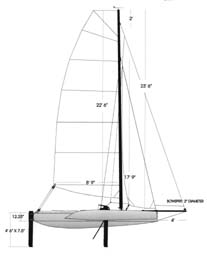 the bow wave and planing. Once
on a plane a new speed restriction takes over. This is friction of the boat over the
wetted surface; water. The less the wetted surface, or, the more of the boat which is out
of the water, the faster the boat will go. This is why sportboats, planing multihulls and
even Whitbread 60’s are so fast compared to boats restricted to the bow
wave/waterline formula.
the bow wave and planing. Once
on a plane a new speed restriction takes over. This is friction of the boat over the
wetted surface; water. The less the wetted surface, or, the more of the boat which is out
of the water, the faster the boat will go. This is why sportboats, planing multihulls and
even Whitbread 60’s are so fast compared to boats restricted to the bow
wave/waterline formula.
The ultimate reduction in wetted surface area is to take the boat
completely out of the water. The Rave hydrofoil ultimately reduces wetted surface area to
about 22 to 23 square feet. This allows the sailplan to power up the boat to fly to some
new theoretical limits imposed by cavitation over the hydrofoil wings (bubbles over the
wings). The generally accepted maximum before meeting the cavitation barrier is about 42
knots. The recommended top speed of the Rave is 30 knots.
The complexity of the hydrofoil boat arises from the fact that it sails
under all the speed barriers at different times and is able to overcome all but cavitation
at different times. See the related article about the 42 NM Miami to Key Largo race which
included 10 Raves in their first offshore one design class.
The RAVE
The first thing that impressed me is how extraordinarily well the boat
performs as a sailboat when not on foils. It points 40 to 45 degrees to the apparent wind,
it tacks on a dime with a self-tacking jib and jibes with ease. You can feel everything
that this big powerful rig gives you.
Sailing Flat
Hydrofoil boats need to sail flat to give the wings the proper angle of
incidence in the water. Get used to not heeling. This translates into considerable
stresses since the sailplan is at its optimum when straight up and down. These stresses
are absorbed by the aluminum grid and large cross beam before they are transferred into
power and speed.
Upwind
You have to shake your preconceptions here because you have so much
control over your vertical foils which lift you to windward as well as your horizontal
foils which hoist the boat clear of the water.
In light winds (4 - 8 knots) you are in a displacement mode. The
windward foil is lowered all the way while maintaining your leeward foil at half latch and
your rudder foil at half latch. This configuration gives you a lot of lift to windward
with minimum drag. It is also one of the few times you’ll heel at all.
In a little more breeze, 9 to 14 knots, you can skim to windward. This
is done by taking advantage of the horizontal foils’ lifting power to minimize wetted
surface, thus increasing speed to windward. All foils are fully extended.
In yet more breeze, 15 plus knots, you can foil to windward. All foils
are fully extended, boat speed is between 14 and 18 knots at approximately 58 to 60
degrees to the apparent wind.
Since the windspeed fluctuates, you may not always be on foils upwind.
One efficient method of going upwind is, when you land in the lulls, to trim in and point
up to 45 degrees apparent wind. In the puffs fall off a bit and foil to windward at high
speed.
Beam Reaching
This is the fastest point of sail and the one which requires the least
amount of wind in order to come out of the water on foil. It is not uncommon to bring a
Rave up on foil in 8 to 9 knots of wind. As your skill increases you can do flying jibes.
This is when the G-forces remind you that its very nice to be captured in a seat.
Broad Reaching
The further downwind you go the slower the boat goes relative to the
windspeed and the less stress you put on the boat. In very high winds, if you come off
foil without pointing the boat into the wind, you are most vulnerable to nosing the boat
over. This is not a violent pitch pole such as in some high speed beach cats, but rather a
slow elevator ride to 90 degrees.
Company History
Wilderness Systems began in Andy Zimmerman’s garage in 1985. Andy
and his partner, John Sheppard, decided to build a few kayaks for their friends. They had
both recently left the furniture industry. Building whitewater kayaks seemed to be more
fun.
Despite the fact that the market appeared to be already saturated, it
turned out to be more than just fun, it became a great success. They found a niche in
building touring kayaks, an item which other companies were not very interested in at the
time.
The glitch in the production process was that their hand-made boats
were too expensive to produce. So, in 1991 they began the rotational molding process, and
applied it to their most popular touring kayak, the Sealution. The result was a high-level
performance kayak at almost half the price of the composite version!
The real explosion in sales came when the company, using its own
in-house research and development team, created a new line of kayaks for the masses which
were stable, inexpensive and easy to paddle. In 1993 the Rascal was born and became an
instant hit.
Through the years the company offered several versions of sailing
kayaks. When Andy and John teamed up with Jim Brown, creator of the SeaRunner 31 and 37,
the WindRider trimaran was created as a new product and WindRider Sailing Trimarans became
a new division within the company.
In 1996 the first roto-molded, wave-piercing trimaran left the factory,
followed by hundreds more. According to Andy, Wilderness Systems is building over 30,000
small boats a year.
Construction
The Rave, like WindRider, is roto molded polyethylene plastic. The raw
material is a powder which is poured into a mold then rotated and baked. After the baking
process, it takes 20 - 30 minutes for cooling to take place. Then assembly begins. Pieces
such as cut-outs and shavings are reground and reused. It is almost a "no waste"
process.
The difference between rotational molding manufacturers is primarily
how they use the process to build boats. Since polyethylene is a really tough, but
relatively soft, pliable material, it gains its structural strength by creating curves,
ridges, angles, pegs between layers, etc. The downside of this is that when there is
enough plastic in place to deal with the rig loads and hull stresses of sail boats, the
boat tends to get "heavy" and the continual flexing may degrade the stress
points anyway.
Andy and Wilderness Systems have taken a far superior approach by using
the roto molded polyethylene to keep the water out of the boat or to "float the
boat." The structural integrity, and tremendous stress loads of the RAVE hydrofoil
are taken by an aircraft aluminum tubing structure which is both simple and strong. Even
the foils are aluminum and they are supported by a large five inch aluminum crossbeam.
The Foil System
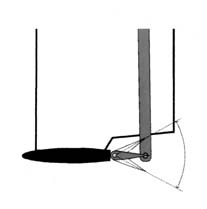 The crossbeam and tubing grid support three inverted
"T" shaped hydrofoils. The left and right foils have an automatic control arm
which adjusts the aileron flap on the back of the wing. This mechanical system controls
lift and drag to keep the boat flying evenly through the water at the right depth. Bungee
adjusting cords are manually controlled from the cockpit to assist and tune the automatic
system. All the foils have three positions: all the way up, all the way down and
half-latch. If the boat is moving the foils can be flown to the proper position either up
or down.
The crossbeam and tubing grid support three inverted
"T" shaped hydrofoils. The left and right foils have an automatic control arm
which adjusts the aileron flap on the back of the wing. This mechanical system controls
lift and drag to keep the boat flying evenly through the water at the right depth. Bungee
adjusting cords are manually controlled from the cockpit to assist and tune the automatic
system. All the foils have three positions: all the way up, all the way down and
half-latch. If the boat is moving the foils can be flown to the proper position either up
or down.
The stock rudder foil is a neutral, following wing. As the front foils
rise, the angle of incidence increases giving the rudder foil lift to raise the boat
completely out of the water. When the boat is foil borne the rudder foil returns to near
neutral.
The adjustable pitch rudder which I prefer has an aileron on the back
of the foil just like the side foils do. You control the lift and drag by moving a control
arm on the side of the cockpit. This can assist when becoming foilborne and in tuning the
boat when on foil.
The Rig
The large-roach, full-batten mainsail is boomless. After jibing a
couple of times at 20 plus knots, it’ll make sense. The jibe is over in a couple of
seconds and you are off on the other tack without ever leaving your foil "feet."
This is another time when warp speed is added to your sailing vocabulary.
The jib is small and self-tacking. It obviously works very well because
the boat tacks on a dime. It’s so much better than comparable sized beach catamarans
when tacking that it sets a new standard more akin to quick monohulls.
The roller-furling reacher adds 97 sq. ft. to the already impressive
193 sq. ft. sailplan. The reacher extends the wind range. It is easy to handle and powers
up the boat in lighter air. It also allows lower downwind angles when flying on foil. This
sail is usually referred to as the screecher by multihull enthusiasts.
The Rave has a rotating aluminum foil-shaped spar with upper and lower
shrouds but no backstay. It’s a relatively simple, cost-effective rig which performs
well.
The Designers
Dr. Sam Bradfield is a jewel of a person. His passion is sailing fast.
He spent eight years at the University of Minnesota in aeronautical engineering before
moving back to private industry and eventually to Florida. His expertise in fluid dynamics
and advanced wind powered watercraft eventually led to hydrofoils. He designed NF2,
Neither Fish Nor Fowl. Nf2 captured and held the Class C world speed sailing record
between 1978 and 1982.
Sam and his associates at HydroSail, Inc., Mike McGarry and Tom Haman,
set their sights on developing practical applications which could bring hydrofoil sailing
and racing to regular folks. They developed foils for wind surfers and retrofits for
catamarans. According to Mike, one of the problems with retrofits is that the original
boats were not designed to handle the additional loads required to sail flat with
hydrofoils. "It’s much easier to design the boat right from scratch."
Sam beamed when I told him that the factory just placed the 150th Rave
order since last August. "It has been a really great team effort between the factory
and the design team. It wouldn’t have happened without great sacrifice and
cooperation between both teams."
How Tough Is Tough?
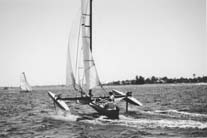 A friend of mine got his Rave and immediately launched it in North Dakota. He
went out and sailed in 30 knot winds without a reef (recommended at 20 knots). He promptly
ran aground at a speed of 30 knots. The extent of the damage was a cracked weld where the
crossbeam bolts together.
A friend of mine got his Rave and immediately launched it in North Dakota. He
went out and sailed in 30 knot winds without a reef (recommended at 20 knots). He promptly
ran aground at a speed of 30 knots. The extent of the damage was a cracked weld where the
crossbeam bolts together.
Another Rave owner ran aground in shallow water in Florida going about
28 knots. He broke his foil on the coral. Replacement cost was under $400. Imagine any
other boat, power or sail, running aground at these speeds. The owners would be fortunate
if the boats weren’t total losses.
I pitched my Rave forward in a 30 plus knot gust by flying the leeward
foil out of water at very high speed. This caused the boat to turn dead downwind with all
of its sails up and no way to release the main past the shrouds. It was a slow elevator
ride up and neither I nor the boat suffered any damage. I'm an advocate of reefing and
paying attention to both foils now!
Conclusion
The WindRider Rave is a fun boat to sail in displacement mode.
It’s a fine sailboat with good speed and pointing ability. Its large square-topped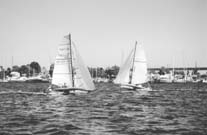 main,
rotating mast, self-tacking jib, asymmetrical roller furling screecher package and, of
course, the foil system allow for plenty of growth for the experienced sailor while
novices can successfully "fly" it. Changing gears in a machine like this is
almost redefining the term.
main,
rotating mast, self-tacking jib, asymmetrical roller furling screecher package and, of
course, the foil system allow for plenty of growth for the experienced sailor while
novices can successfully "fly" it. Changing gears in a machine like this is
almost redefining the term.
Somehow, a scream or hoot escapes from even the most experienced
sailors when the craft first comes up on foil. The boat is completely out of the water and
you are moving along smoothly at 1.5 to 2.0 times windspeed. Pause for a moment and
remember what you’re doing on a conventional or sport boat when its topped out (white
knuckles - heeled and hiked to the max). On the Rave you’re comfortably sitting in
your seat "flying" your machine.
I get a special charge when powerboats and jet skis try to vector an
intercept course to figure out or clock the Rave. A big smile creeps onto my face as I
pass every high tech machine in sight often at two or three times their boat speed knowing
my checkbook took a minor hit and I didn’t have to coordinate a half dozen crew
members.
Possibly the strongest suit this boat has is the ability of a wide
range of folks from novice to very experienced to have fun, fly a modest speeds and doing
it all from the comfort of your own seat. If you’re looking for a well-designed,
innovative, fun, comfortable machine with a growing one design class which is really
comfortable for you and your passenger, the Rave may be it.
Thom Burns publishes Northern Breezes. He also reps WindRider
Trimarans in eight midwestern states.
For more info: Call 800-311-7245 or 612-542-9707.
About Sailing Breezes Magazine
Please send us your comments!!
All contents
are copyright (c) 1998
by Northern Breezes, Inc. All information contained within is deemed reliable but carries
no guarantees. Reproduction of any part or whole of this publication in any form by
mechanical or electronic means, including information retrieval is prohibited except by
consent of the publisher.
 I ordered the boat before it was in production after having sailed the
prototypes a couple of times in Florida. I took possession just before Labor Day, which in
this part of the world means I had about a month to sail it before being driven off the
lake by ol’ man winter. I’ve been holding off writing this review for awhile
because I wanted to confidently say what this boat really does. That confidence came
together when I attended the first national RAVE hydrofoil clinic held at Jensen Beach,
Florida in April.
I ordered the boat before it was in production after having sailed the
prototypes a couple of times in Florida. I took possession just before Labor Day, which in
this part of the world means I had about a month to sail it before being driven off the
lake by ol’ man winter. I’ve been holding off writing this review for awhile
because I wanted to confidently say what this boat really does. That confidence came
together when I attended the first national RAVE hydrofoil clinic held at Jensen Beach,
Florida in April. Before diving into the particular characteristics of
Before diving into the particular characteristics of  the bow wave and planing. Once
on a plane a new speed restriction takes over. This is friction of the boat over the
wetted surface; water. The less the wetted surface, or, the more of the boat which is out
of the water, the faster the boat will go. This is why sportboats, planing multihulls and
even Whitbread 60’s are so fast compared to boats restricted to the bow
wave/waterline formula.
the bow wave and planing. Once
on a plane a new speed restriction takes over. This is friction of the boat over the
wetted surface; water. The less the wetted surface, or, the more of the boat which is out
of the water, the faster the boat will go. This is why sportboats, planing multihulls and
even Whitbread 60’s are so fast compared to boats restricted to the bow
wave/waterline formula. The crossbeam and tubing grid support three inverted
"T" shaped hydrofoils. The left and right foils have an automatic control arm
which adjusts the aileron flap on the back of the wing. This mechanical system controls
lift and drag to keep the boat flying evenly through the water at the right depth. Bungee
adjusting cords are manually controlled from the cockpit to assist and tune the automatic
system. All the foils have three positions: all the way up, all the way down and
half-latch. If the boat is moving the foils can be flown to the proper position either up
or down.
The crossbeam and tubing grid support three inverted
"T" shaped hydrofoils. The left and right foils have an automatic control arm
which adjusts the aileron flap on the back of the wing. This mechanical system controls
lift and drag to keep the boat flying evenly through the water at the right depth. Bungee
adjusting cords are manually controlled from the cockpit to assist and tune the automatic
system. All the foils have three positions: all the way up, all the way down and
half-latch. If the boat is moving the foils can be flown to the proper position either up
or down. A friend of mine got his Rave and immediately launched it in North Dakota. He
went out and sailed in 30 knot winds without a reef (recommended at 20 knots). He promptly
ran aground at a speed of 30 knots. The extent of the damage was a cracked weld where the
crossbeam bolts together.
A friend of mine got his Rave and immediately launched it in North Dakota. He
went out and sailed in 30 knot winds without a reef (recommended at 20 knots). He promptly
ran aground at a speed of 30 knots. The extent of the damage was a cracked weld where the
crossbeam bolts together. main,
rotating mast, self-tacking jib, asymmetrical roller furling screecher package and, of
course, the foil system allow for plenty of growth for the experienced sailor while
novices can successfully "fly" it. Changing gears in a machine like this is
almost redefining the term.
main,
rotating mast, self-tacking jib, asymmetrical roller furling screecher package and, of
course, the foil system allow for plenty of growth for the experienced sailor while
novices can successfully "fly" it. Changing gears in a machine like this is
almost redefining the term.